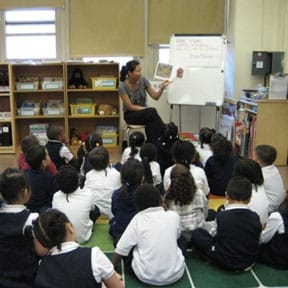DTM: P.S. 83 Luis Rivera Elementary School
Awarded the Dispelling the Myth Award in 2009, P.S. 83 Luis Rivera Elementary School continues to outperform much wealthier schools in New York City and state. East Harlem, in Manhattan, is a neighborhood with a long history, which means that several generations of families have sent their children to P.S. 83 — including the family of the principal, Frances Castillo. “I grew up in the neighborhood,” she said. And in her family, which came from Puerto Rico in the 1950s, “School was the most important thing.” As principal since 2001, Castillo has brought an order and consistency to the school which, even when her children attended was, she said, “a revolving door of teachers.” In 2009 — the year the school won the Dispelling the Myth Award — she said, “The school is calmer, the kids are calmer — we haven’t had a fight in four years.” She credited the teachers who, she said, “have an investment in the kids, they have an investment in the school, they have an investment in the parents.” The teachers, in turn, credited Castillo. “The principal is the glue,” said one. “We are not too proud to say we’re having trouble,” said another. “We all bounce ideas off each other. Early on, Castillo and her assistant principal, Hazel Cruz, established an instructional cabinet, made up of grade-level chairs, which meets once a month and makes many of the decisions for the school. The cabinet has a hiring committee to help with hiring decisions and an inquiry committee that grapples with the question of how the school can be improved. This means that the more-or-less constant state of flux that all schools are in is managed within a structure of constant communication and consultations. And over the years there have been many changes, beginning by throwing out the old basal readers and replacing them with “print-rich” classrooms with hundreds of books each; incorporation of careful phonics and phonemic awareness instruction; adoption of a positive behavioral support program and a character education program; applying for a school-based medical clinic through Mount Sinai; participating in the city’s elementary school ballroom dancing program; and much more. The faculty engage in continual reflection on their practice, reflection that is not only encouraged but scheduled. For example, every year Castillo and Cruz lead three walkthroughs of the building looking for patterns: Are students engaged in instruction? Are the classrooms organized to support instruction? Is there evidence that teachers are planning what they are teaching and then teaching it? Do the teachers have evidence of what their students are learning? In addition, teachers are scheduled to visit another colleague’s classroom every month and are expected to report what they learned and what they will try in their classroom. These are in addition to the formal observation process and the one-on-one conferences that each teacher has with Castillo or Cruz three times a year. During these sessions, teachers are expected to talk about their plans to address the needs of each student and to identify “an area of struggle you had or anticipate having,” with the very next question being, “How can we support you?” All of this makes for a vibrant professional community. As an example, not only is student work posted in the hallways but teachers’ work, from book studies and other professional development, is also posted — a visible reminder to students and the community that schools are places where everyone is learning. “I think I push the kids hard,” Castillo said. But the kids don’t seem to mind. And a second-grader agreed, saying, “I like it here. It’s the best school.” Updated 2013
“The more you feel that what you’re doing makes a difference, the more you do.”
—Frances Castillo, principal
School Overview
